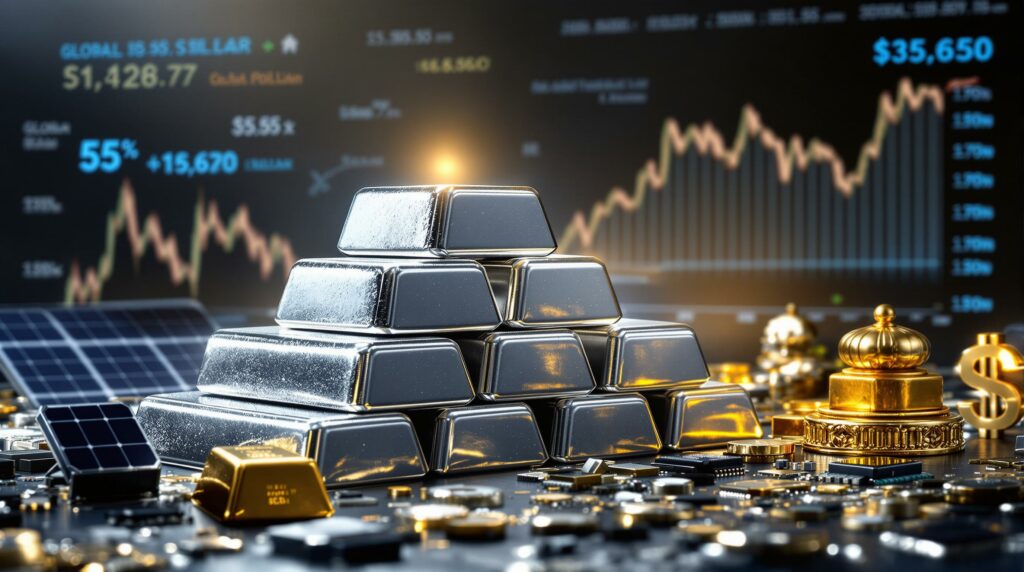Why Is Silver Gaining Momentum in 2025?
Silver has emerged as a standout performer in the precious metals market, with HSBC significantly raising its silver price outlook on gold strength and geopolitical risks for the coming years. This upward revision reflects silver's growing appeal amid global economic uncertainties and its close relationship with gold's remarkable performance. As investors seek safe-haven assets in an increasingly volatile global landscape, silver's dual role as both a precious and industrial metal positions it uniquely in the market.
HSBC's Updated Silver Price Projections
HSBC has substantially increased its silver price forecasts for the next three years:
| Year | New Forecast | Previous Forecast | Increase |
|---|---|---|---|
| 2025 | $35.14/oz | $30.28/oz | +16.0% |
| 2026 | $33.96/oz | $26.95/oz | +26.0% |
| 2027 | $31.79/oz | $28.30/oz | +12.3% |
These revised projections signal HSBC's growing confidence in silver's medium-term prospects, despite expectations of a gradual price moderation after 2025. The significant upward adjustment—particularly the 26% increase for 2026—highlights the bank's bullish outlook on silver's potential in the coming years.
How Is Gold Influencing Silver's Performance?
The Gold-Silver Relationship
Silver's impressive rally is primarily driven by its historical correlation with gold rather than its own fundamental supply-demand dynamics. HSBC analysts note that gold prices analysis shows record-high values exerting a "strong gravitational pull" on silver, effectively dragging silver prices higher despite mixed signals from industrial demand.
This relationship underscores the importance of understanding gold-silver ratio analysis when examining silver's price movements. While silver has industrial applications that gold largely lacks, its price action often follows gold's lead, especially during periods of economic uncertainty.
Gold's Record-Breaking Run
Gold prices have surged approximately 29% in 2025, reaching an unprecedented $3,500 per ounce in April. This remarkable performance has been fueled by:
- Escalating US-China trade tensions
- Ongoing geopolitical conflicts
- Investor flight to safe-haven assets
- Anticipated Federal Reserve rate cuts
As gold continues to break records, silver typically follows suit, though often with more pronounced volatility due to its smaller market size and dual industrial-investment nature. This relationship creates both opportunities and risks for silver investors.
What's Happening with Silver Supply and Demand?
Industrial Demand Outlook
After four consecutive years of record growth, industrial demand for silver is expected to slightly decline in 2025. However, HSBC emphasizes that this pullback will likely be modest and temporary, with demand projected to recover in 2026. Key industrial sectors driving silver demand include:
- Photovoltaic (solar) industry
- Electronics manufacturing
- Electric vehicle components
- Medical applications
The photovoltaic sector remains particularly important, as global renewable energy investments continue to expand despite short-term fluctuations. Silver's excellent conductivity makes it essential for high-efficiency solar panels, creating a structural support for demand.
Investment and Consumer Demand
While industrial applications remain relatively robust, other demand segments are showing signs of weakness:
- Jewelry and silverware demand: Expected to continue declining due to persistently high prices
- Coin and bar demand: Weakening after previous strong purchasing cycles and in response to elevated price levels
These trends highlight how price sensitivity affects different segments of the silver market. As prices rise, consumer-oriented applications typically experience demand destruction, while industrial uses—which often require smaller quantities per product—show greater resilience.
Mining Production and Market Balance
Silver mine output continues to increase at a moderate pace, though not enough to offset demand. HSBC's supply-demand model forecasts:
| Year | Projected Deficit (million oz) |
|---|---|
| 2024 | 167 |
| 2025 | 206 |
| 2026 | 126 |
These substantial market deficits should provide fundamental support for prices, even as the deficit narrows in 2026. The persistent supply shortfall suggests that prices may remain elevated even if investment demand moderates.
How Are Macroeconomic Factors Affecting Silver?
Currency Dynamics
The US dollar's performance significantly impacts silver prices, with a weaker dollar typically supporting higher silver valuations. HSBC's research indicates the dollar may weaken through 2025, creating a favorable environment for silver prices.
Since precious metals are typically priced in dollars, currency movements create an inverse relationship—as the dollar weakens, more dollars are required to purchase the same amount of silver, effectively raising its price. This relationship becomes particularly important during periods of currency volatility.
Interest Rate Policies
The ongoing debate surrounding Federal Reserve rate cuts remains a critical factor for silver's outlook. Lower interest rates generally benefit non-yielding assets like precious metals by reducing the opportunity cost of holding them. Market expectations for rate cuts in late 2025 could provide additional support for silver prices.
Interest rate policies also influence broader market sentiment, with accommodative monetary policy often driving investors toward risk assets and inflation hedges, both of which can benefit silver prices.
What Are the Key Drivers for Silver's Future Performance?
Geopolitical Uncertainty
Escalating global tensions, including the US-China trade war and various regional conflicts, continue to drive investors toward safe-haven assets. Silver benefits from this risk-averse sentiment, particularly when accompanied by gold's strong performance.
Unlike purely industrial metals, silver's precious metal status means it tends to appreciate during periods of geopolitical instability. This characteristic provides an important countercyclical element to its price performance.
Industrial Recovery Potential
While industrial demand may temporarily soften in 2025, the projected recovery in 2026 could provide renewed support for silver prices. The photovoltaic sector, in particular, remains a crucial growth driver as global renewable energy investments continue to expand.
The temporary softening in industrial demand should be viewed in context of the sector's strong performance over the previous four years. Rather than representing a structural decline, current projections suggest more of a cyclical adjustment.
Investment Flows
Despite some weakening in retail investment demand, institutional interest in silver could increase if inflation concerns persist or geopolitical risks escalate further. ETF flows and futures positioning will be important indicators of investment sentiment toward silver.
Silver's smaller market size compared to gold means that relatively modest shifts in investment allocation can have outsized impacts on price. This dynamic creates both opportunities and risks, as silver typically experiences greater price volatility than its yellow metal counterpart.
What Should Investors Consider About Silver in 2025-2027?
Price Volatility Expectations
Silver typically exhibits greater price volatility than gold, making it both potentially more rewarding and riskier for investors. The metal's smaller market size means large investment flows can cause significant price movements in either direction.
This volatility characteristic makes silver particularly suited for investors with higher risk tolerance or those employing tactical allocation strategies. For conservative investors, smaller allocations or dollar-cost averaging approaches may help manage this inherent volatility.
Industrial vs. Investment Demand Balance
Understanding the balance between silver's industrial applications and its role as an investment asset is crucial for forecasting price movements. When investment demand dominates, as in the current environment, prices can disconnect from industrial fundamentals.
This dual nature creates interesting market dynamics, as silver often behaves like gold during periods of financial stress but more like an industrial metal during economic expansion. Monitoring the shifting balance between these demand segments provides important context for price movements.
Supply Constraints
With projected market deficits continuing through 2026, supply constraints could support higher prices even if investment demand moderates. Mining production increases remain modest relative to overall demand.
Unlike many industrial metals, significant portions of silver come as byproducts from mining operations primarily focused on other metals like copper, lead, and zinc. This characteristic means that silver supply doesn't always respond directly to silver prices, creating potential for sustained silver market squeeze conditions.
Conclusion: Silver's Outlook in a Volatile Global Economy
HSBC's revised silver price outlook on gold strength and geopolitical risks reflects growing confidence in the metal's prospects amid global economic and geopolitical uncertainties. While primarily benefiting from gold's strong performance rather than its own fundamentals, silver's projected supply deficits provide additional support for higher prices.
Investors should monitor key factors including gold price movements, Federal Reserve policy decisions, US dollar strength, and industrial demand trends—particularly in the photovoltaic sector—when evaluating silver's potential. The metal's dual nature as both an industrial commodity and investment asset continues to create a complex but potentially rewarding opportunity in the precious metals analysis space.
Disclaimer: This article contains forecasts and market analysis that may not materialise as predicted. Investment decisions should be made based on thorough personal research and consultation with financial advisors. Past performance is not indicative of future results.
Key Points to Remember
- Silver prices are forecast to reach $35.14/oz in 2025 before moderating slightly in subsequent years
- Gold's strong performance is the primary driver of silver's price rally
- Projected supply deficits should provide fundamental support through 2026
- Industrial demand, while temporarily softening, is expected to recover in 2026
- Silver's dual nature as both precious and industrial metal creates unique market dynamics
Looking for the Next Silver Bull Run?
Discover significant ASX mineral opportunities, including silver mining stocks, before they make headlines with Discovery Alert's proprietary Discovery IQ model, which transforms complex market data into actionable insights for savvy investors. Explore how major mineral discoveries can lead to exceptional returns by visiting Discovery Alert's dedicated discoveries page and position yourself ahead of the market.




